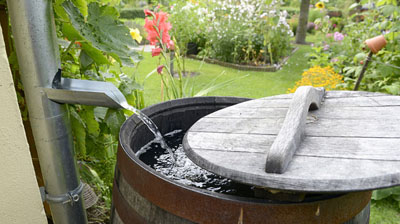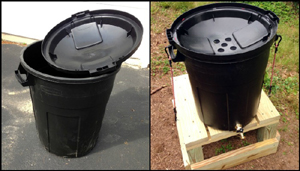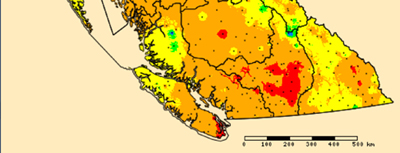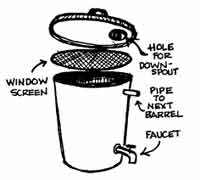Sunday September 17, 2023 | LANGFORD, BC
by Mary P Brooke, B.Sc. | Island Social Trends | FOOD SECURITY SECTION | Public talks on Urban Food Resilience
Smart irrigation including rainwater harvesting is something that residents of the Greater Victoria area will probably start thinking about more.
Anyone who has been growing food in their own yard this summer has been acutely aware of how the drought that carried over from autumn 2022 into winter/spring 2023 has been a challenge to keeping soils moist.
As well, when autumn rain eventually comes (currently in the forecast for a few days starting September 25) the ground may be quite dry and therefore resistant to a sudden influx of water. Prepare your garden and yard soil by puncturing small holes around the property, to help loosen up soil that may have become compacted.
Catch your own rainwater:
Collection of rain water can be done quite simply by leaving out clean plastic garbage cans during the rainy season (usually November through February), and perhaps also a good idea in this upcoming September return of rain.
Depending on the number of cans collecting water, the supply can last into May or June of the gardening season. That avoids having to use treated drinking water for watering your garden.
Even small plastic pails or buckets that you use in your gardening work can be handy short-term rain collectors.
All summer long, BC government officials have asked people to conserve water, and to not take for granted the easy access we have to treated tap water in our communities.
Fall veggie garden:
South Vancouver Island already enjoys a Mediterranean climate zone in which vegetables and other edibles can be grown from April through September. In recent years that period has extended from March into October, especially in the warmer zones in Langford and Colwood.
Use your fresh collected rainwater to keep your vegetable plantings watered in the coming weeks.
Rain barrel water should of course never be used for human consumption, and should be covered over in the buckets if you plan to use it over the course of a few weeks.
CRD rainwater harvesting info:
The Capital Regional District (CRD) has for many years offered information about rainbarrels that can capture water from a roof through the downspouts of eavestroughs and hold it for later use such as on lawns, gardens or indoor plants.
The average roof in the CRD can collect 272 litres of rain (60 gallons) on each nine square metres (about 100 square feet) for every 25mm (one inch) of rain.
The CRD rainwater harvesting webpage has lots of information, including the benefits of rainwater harvesting:
- Saves treated drinking water.
- Free source of water.
- Delays peak runoff during a rainfall event which reduces the burden on our infrastructure.
- Reduces the pressure on storm drainage and the sanitary sewer system.
- Reduces soil erosion from the foundation of your home.
- Promotes healthy plants, as rain water is the ambient temperature, has micro-nutrients and is chlorine-free.
- Using rainwater for irrigation, will help to replenish groundwater stores.
Food security news section:
Remember to check in at the Island Social Trends Food Security news section for all sorts of updates about agriculture and food.








